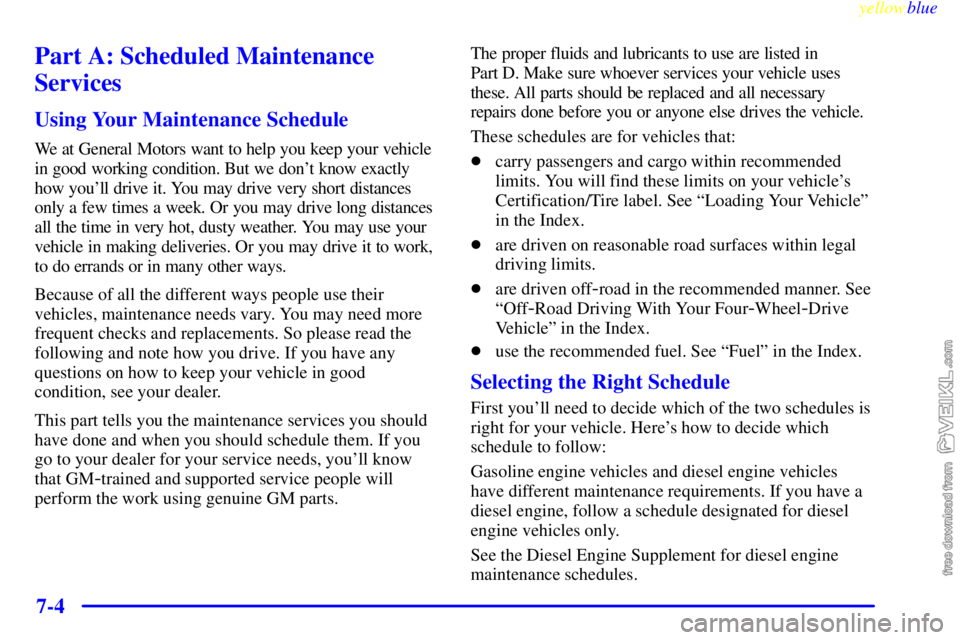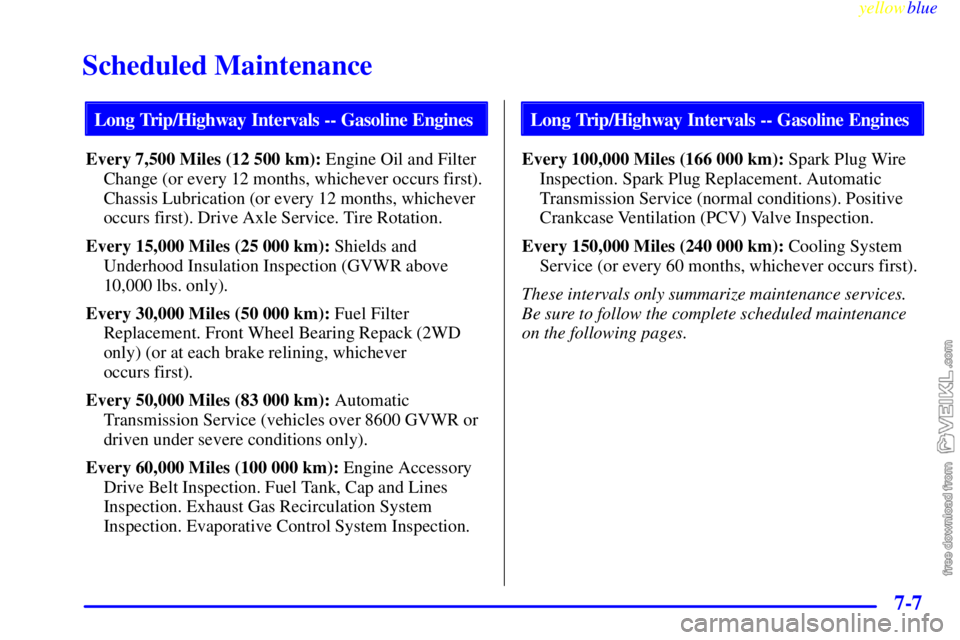Page 358 of 440
yellowblue
6-76
Capacities and Specifications
Please refer to ªRecommended Fluids and Lubricantsº in the Index for more information.
Engine Type VIN Code Spark Plug Gap
ªVORTECº 5000 V8 M 0.06 inches (1.52 mm)
ªVORTECº 5700 V8 R 0.06 inches (1.52 mm)
ªVORTECº 7400 V8 J 0.06 inches (1.52 mm)
Wheels and Tires
Model Description Torque
C/K 1500 5 bolts (14 mm)
140 lb
-ft (190 N´m)
C/K 1500 and C/K 2500 6 bolts (14 mm)
140 lb
-ft (190 N´m)
C/K 2500 (w/C6P) 8 bolts (14 mm)
140 lb
-ft (190 N´m)
C/K 3500 (Single Rear Wheels) 8 bolts (14 mm)
140 lb
-ft (190 N´m)
C/K 3500 (Dual Rear Wheels) 8 bolts (14 mm)
140 lb
-ft (190 N´m)
C 3500 HD Front 5 bolts (5/8 in.)
175 lb
-ft (240 N´m)
C 3500 HD Rear 10 bolts (5/8 in.)
175 lb
-ft (240 N´m)
Tire Pressure See the Certification/Tire label on the rear edge of the driver's door
or the incomplete vehicle document in the cab.
Page 359 of 440

yellowblue
6-77 Cooling System Capacity (Approximate)
After refill, the level must be rechecked. See ªCooling
Systemº in the Index.
Engine VIN Quantity
ªVORTECº 5000 M 17.5 quarts (16.6 L)
ªVORTECº 5700 R 17.5 quarts (16.6 L)
ªVORTECº 7400 J 25.0 quarts (23.5 L)
ªVORTECº
7400 w/3500 HDJ 28.5 quarts (27.0 L)
Crankcase Capacity (Approximate)
After refill, the level must be rechecked. Add enough
engine oil so that the fluid is within the proper operating
range. See ªEngine Oilº in the Index.
Engine VIN
Quantity with Filter�
ªVORTECº 5000 M 5.0 quarts (4.8 L)
ªVORTECº 5700 R 5.0 quarts (4.8 L)
ªVORTECº 7400 J 6.6 quarts (6.3 L)
�Oil filter should be changed at every oil change.
Fuel Tank Capacity (Approximate)
Type Quantity
Short Bed 26 gallons (98 L)
Long Bed 34 gallons (128 L)
Standard Crew Cab 34 gallons (128 L)
Chassis
-Cab Front Tank 21 gallons (79 L)
Chassis
-Cab Rear Tank 18 gallons (68 L)
3500 HD Models Front Tank 21 gallons (79 L)
3500 HD Models Rear Tank 18 gallons (68 L)
Page 363 of 440
7-
yellowblue
7-1
Section 7 Maintenance Schedule
This section covers the maintenance required for your vehicle. Your vehicle needs these services to retain its safety,
dependability and emission control performance.
7
-2 Introduction
7
-4 Part A: Scheduled Maintenance
7
-5 Short Trip/City Definition -- Gasoline
Engines
7
-5 Short Trip/City Intervals -- Gasoline Engines
7
-6 Long Trip/Highway Definition -- Gasoline
Engines
7
-7 Long Trip/Highway Intervals -- Gasoline
Engines7
-8 Short Trip/City Scheduled
Maintenance
-- Gasoline Engines
7
-30 Long Trip/Highway Scheduled
Maintenance
-- Gasoline Engines
7
-41 Part B: Owner Checks and Services
7
-46 Part C: Periodic Maintenance Inspections
7
-48 Part D: Recommended Fluids and Lubricants
7
-51 Part E: Maintenance Record
Page 366 of 440

yellowblue
7-4
Part A: Scheduled Maintenance
Services
Using Your Maintenance Schedule
We at General Motors want to help you keep your vehicle
in good working condition. But we don't know exactly
how you'll drive it. You may drive very short distances
only a few times a week. Or you may drive long distances
all the time in very hot, dusty weather. You may use your
vehicle in making deliveries. Or you may drive it to work,
to do errands or in many other ways.
Because of all the different ways people use their
vehicles, maintenance needs vary. You may need more
frequent checks and replacements. So please read the
following and note how you drive. If you have any
questions on how to keep your vehicle in good
condition, see your dealer.
This part tells you the maintenance services you should
have done and when you should schedule them. If you
go to your dealer for your service needs, you'll know
that GM
-trained and supported service people will
perform the work using genuine GM parts.The proper fluids and lubricants to use are listed in
Part D. Make sure whoever services your vehicle uses
these. All parts should be replaced and all necessary
repairs done before you or anyone else drives the vehicle.
These schedules are for vehicles that:
�carry passengers and cargo within recommended
limits. You will find these limits on your vehicle's
Certification/Tire label. See ªLoading Your Vehicleº
in the Index.
�are driven on reasonable road surfaces within legal
driving limits.
�are driven off
-road in the recommended manner. See
ªOff
-Road Driving With Your Four-Wheel-Drive
Vehicleº in the Index.
�use the recommended fuel. See ªFuelº in the Index.
Selecting the Right Schedule
First you'll need to decide which of the two schedules is
right for your vehicle. Here's how to decide which
schedule to follow:
Gasoline engine vehicles and diesel engine vehicles
have different maintenance requirements. If you have a
diesel engine, follow a schedule designated for diesel
engine vehicles only.
See the Diesel Engine Supplement for diesel engine
maintenance schedules.
Page 367 of 440

Scheduled Maintenance
yellowblue
7-5
Short Trip/City Definition -- Gasoline Engines
Follow the Short Trip/City Scheduled Maintenance if
any one of these conditions is true for your vehicle:
�Most trips are less than 5 to 10 miles (8 to 16 km).
This is particularly important when outside
temperatures are below freezing.
�Most trips include extensive idling (such as frequent
driving in stop
-and-go traffic).
�You operate your vehicle in dusty areas or
off
-road frequently.
�You frequently tow a trailer.
�If the vehicle is used for delivery service, police, taxi
or other commercial application.
One of the reasons you should follow this schedule if
you operate your vehicle under any of these conditions
is that these conditions cause engine oil to break
down sooner.
Short Trip/City Intervals -- Gasoline Engines
Every 3,000 Miles (5 000 km): Engine Oil and Filter
Change (or 3 months, whichever occurs first). Chassis
Lubrication (or 3 months, whichever occurs first).
Drive Axle Service (or 3 months, whichever
occurs first).
Every 6,000 Miles (10 000 km): Tire Rotation.
Every 15,000 Miles (25 000 km): Shields and
Underhood Insulation Inspection (GVWR above
10,000 lbs. only). Front Wheel Bearing Repack
(2WD only) (or at each brake relining, whichever
occurs first).
Every 30,000 Miles (50 000 km): Fuel Filter
Replacement.
Every 50,000 Miles (83 000 km): Automatic
Transmission Service (vehicles over 8600 GVWR or
driven under severe conditions only).
(Continued)
Page 368 of 440

Scheduled Maintenance
yellowblue
7-6
Short Trip/City Intervals -- Gasoline Engines
Every 60,000 Miles (100 000 km): Engine Accessory
Drive Belt Inspection. Fuel Tank, Cap and Lines
Inspection. Exhaust Gas Recirculation System
Inspection. Evaporative Control System Inspection.
Every 100,000 Miles (166 000 km): Spark Plug Wire
Inspection. Spark Plug Replacement. Automatic
Transmission Service (normal conditions). Positive
Crankcase Ventilation (PCV) Valve Inspection.
Every 150,000 Miles (240 000 km): Cooling System
Service (or every 60 months, whichever occurs first).
These intervals only summarize maintenance services.
Be sure to follow the complete scheduled maintenance
on the following pages.
Long Trip/Highway Definition -- Gasoline Engines
Follow this scheduled maintenance only if none of the
conditions from the Short Trip/City Scheduled
Maintenance is true. Do not use this schedule if the
vehicle is used for trailer towing, driven in a dusty area
or used off paved roads. Use the Short Trip/City
schedule for these conditions.
Driving a vehicle with a fully warmed engine under
highway conditions causes engine oil to break
down slower.
Page 369 of 440

Scheduled Maintenance
yellowblue
7-7
Long Trip/Highway Intervals -- Gasoline Engines
Every 7,500 Miles (12 500 km): Engine Oil and Filter
Change (or every 12 months, whichever occurs first).
Chassis Lubrication (or every 12 months, whichever
occurs first). Drive Axle Service. Tire Rotation.
Every 15,000 Miles (25 000 km): Shields and
Underhood Insulation Inspection (GVWR above
10,000 lbs. only).
Every 30,000 Miles (50 000 km): Fuel Filter
Replacement. Front Wheel Bearing Repack (2WD
only) (or at each brake relining, whichever
occurs first).
Every 50,000 Miles (83 000 km): Automatic
Transmission Service (vehicles over 8600 GVWR or
driven under severe conditions only).
Every 60,000 Miles (100 000 km): Engine Accessory
Drive Belt Inspection. Fuel Tank, Cap and Lines
Inspection. Exhaust Gas Recirculation System
Inspection. Evaporative Control System Inspection.
Long Trip/Highway Intervals -- Gasoline Engines
Every 100,000 Miles (166 000 km): Spark Plug Wire
Inspection. Spark Plug Replacement. Automatic
Transmission Service (normal conditions). Positive
Crankcase Ventilation (PCV) Valve Inspection.
Every 150,000 Miles (240 000 km): Cooling System
Service (or every 60 months, whichever occurs first).
These intervals only summarize maintenance services.
Be sure to follow the complete scheduled maintenance
on the following pages.
Page 370 of 440

Short Trip/City Scheduled Maintenance -- Gasoline Engines
yellowblue
7-8
The services shown in this schedule up to 100,000 miles
(166 000 km) should be performed after 100,000 miles
(166 000 km) at the same intervals. The services shown
at 150,000 miles (240 000 km) should be performed at
the same interval after 150,000 miles (240 000 km).
See ªOwner Checks and Servicesº and ªPeriodic
Maintenance Inspectionsº following.
Footnotes
� The U.S. Environmental Protection Agency or the
California Air Resources Board has determined that the
failure to perform this maintenance item will not nullify
the emission warranty or limit recall liability prior to the
completion of the vehicle's useful life. We, however,
urge that all recommended maintenance services be
performed at the indicated intervals and the maintenance
be recorded.# Lubricate the front suspension, kingpin bushings,
steering linkage, transmission shift linkage, transfer case
shift linkage, parking brake cable guides, rear driveline
center splines, front axle propshaft spline and brake
pedal springs. Ball joints and kingpin bushings should
not be lubricated unless their temperature is 10�F
(
-12�C) or higher, or they could be damaged.
+ A good time to check your brakes is during tire
rotation. See ªBrake System Inspectionº under ªPeriodic
Maintenance Inspectionsº in Part C of this schedule.